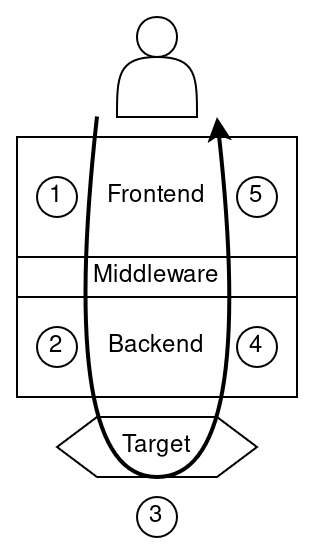Architecture
This document explains the architecture of the current implementation.
The main logic of the POD2 implementation is divided into three modules:
- frontend
- compiles user-friendly pod declarations into intermediate representations to be consumed by the backend
- internally connects to the backend to get pods built (proved).
- presents pods to the user
- middleware
- defines the intermediate representation of Statements, Operations and interfaces of PODs
- Statements and Operations are strongly typed here
- Both frontend and backend use types defined in the middleware
- Does not import types from frontend nor backend
- backend
- takes a middleware POD request representation, signs/proves it and returns a generic POD object
If this was the Rust language compiler:
- frontend: takes a Rust code and compiles it to LLVM-IR
- middleware: defines LLVM-IR instructions and blocks
- backend: Takes LLVM-IR instructions and emits assembly code for a particular CPU
The following diagram shows visually how the components interact with each other:

In this organization, the middleware could be defined at arbitrary points:
- closer to the user would be more high level
- closer to the target would be more low level
All these positions are OK. We just need to choose one, and we can try to choose a point that simplifies the implementation.
For example in the middleware we could define Value = 4 x Goldilock (making it slightly low level); or Value = BigUint and letting the backend choose the maximum representable value, the field encoding, etc. (making it slightly higher level).
In the current iteration we choose Value = 4 x Goldilock, but we can revisit it in a future iteration (eg. if we want to support plonky3) by either moving the middleware to a higher level, or by keeping it the same and replacing the Value definition.
The diagram above includes an arrow that would show the typical flow followed by a user making a POD. This is a simplified description of the process.
- The user interacts with the frontend API and passes a list of Operations. The frontend takes those operations and generates the corresponding Statements. The list of Operations and Statements are transformed into middleware types. This process can be seen as a compilation step. The frontend sends this middleware data as a request to the Backend.
- The backend receives a request to build a POD from a list of Statements and Operations. It takes that bundle of data and lays it out in the appropriate format to be proved by a circuit, padding unused slots, etc. Then it calls a proof system API to generate a proof.
- The target (proof system) generates a proof from some circuit description and witness data and gives it back to the backend.
- The backend receives the proof and encapsulates it in an object that adheres to the Pod trait and passes it to the frontend
- The frontend receives a "blackbox" Pod object and wraps it in a presentation layer in order to show it to the user.